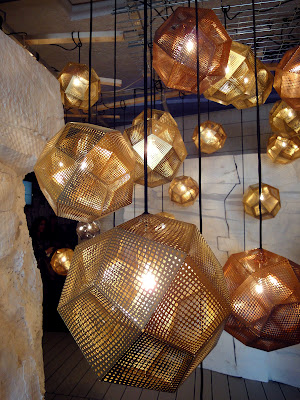As a tradition, Milan Salone was not only a hotspot for celebrated product designers, but also a playground for starchitects. Many architects had “crossed the line” and developed new products with different name brands, both for the buildings they designed and as mass marketed objects.
At the Fairgrounds, Jean Nouvel presented the Mia collection for Emu. These simple and elegant stacking metal chairs and tables were originally for the restaurant of the RBC Design Centre that Nouvel designed in Montpellier. The Molteni&C stand featured the Arc dining table by Foster + Partners. The double-curved base made of a composite material of cement and organic fiber attracted quite a few eyeballs.
 |
| Emu’s MIA collection by Jean Nouvel |
 |
| Arc table by Foster + Partners for Molteni&C |
In Brera, Shigeru Ban showcased Module H, a modular system of aluminum panels he developed for Hermès, of course with a perforated pattern composed of the letter H. It could be used to surface existing walls or as free-standing partition screen. The idea is that the repetitive pattern allows you to hang anything on the wall in all kinds of combinations. Aren’t most of the shelves in stores doing that just as well?
Shigeru Ban’s work was also featured at the showroom of When Objects Work (WOW), alongside that of John Pawson and Belgian architect Vincent van Duysen.
 |
| Maru by Shigeru Ban |
 |
| Tableware by John Pawson |
 |
| Pottery by Vincent van Duysen |
Paola C. Gallery presented a series of wooden objects made by the craftsmen of Studio Mumbai. These curious looking bowls and pots were the result of an almost impossible collaboration: Studio Mumbai founder Bijoy Jain and Aldo Cibic, Italian design guru who was part of the postmodern Memphis group.
 |
| Wooden objects by Bijoy Jain and Aldo Cibic |
The most high profile in Brera this year was probably Zaha Hadid’s “Secret Garden” pavilion with marble producer Citco. The overall fluid gesture of the pavilion looked clever, framing large milled marble murals with cuts and folds. Yet the simple but most important detail – how to fix these pieces onto the structure – was not thought through at all. The inlaid marble surfaces were obvious parametric geometry exercises; but what’s more than that? What are they for? The description claimed that they established a dialogue between nature and architecture: “These fascinating scenarios are established when energy is applied to geology – developing a geometric set of repeated cycles of growth or erosion that have been superimposed onto the immaculate marble.” Hmm, sounds like Patrik talking.
When I first heard that David Adjaye would design some products with Swarovski, I was a bit worried. Bling bling! But to my relief, the Star vessels were very subtle, elegant, and delightful to see. Handmade in Turkey, these objects were lined with black crystals only on the inside, while the copper exteriors were perfectly smooth. “This inversion creates an elemental quality that comes alive as the crystals subtly catch the light from within,” Adjaye said.
 |
| Star vessels by David Adjaye |
Adjaye’s mentor David Chipperfield was featured in the Marsotto Edizioni showroom in the MonteNapoleone area. His Colonnade was one of the new tables presented. Curious enough, this long table and all the other tables (designed by Konstantin Grcic, Naoto Fukasawa, Jasper Morrison, and James Irvine) looked extremely similar. I guess it was the white Carrara marble and the identical matt polished finish.
 |
| Colonnade table by David Chipperfield |
 |
| Konstantin Grcic (left) and Naoto Fukasawa (right) also for Marsotto Edizioni |
On via MonteNapoleone, the Chipperfield-designed Valentino flagship store had an “open house” to show the new store concept. A succession of areas with distinct atmospheres stretched in smooth harmony, thanks to a carefully developed material palette: grey terrazzo, marble in black and white checkerboard pattern, wood, glass, sandblasted mirrors, leather, etc. It was very refined and elegant, yet very plain and hollow. Typical Chipperfield “Tofu Architecture” (as Jin described it): tasteful because of all the add-ons but dull in essence.
A few blocks away, the recently completed Duvetica store hosted an exhibition on Tadao Ando, the architect behind their own retail space. 10 museum projects, including the Punta della Dogana Contemporary Art Center and Palazzo Grassi in Venice as well as Lee Ufan Museum and Chichu Art Museum in Naoshima were presented. I had not been following Ando’s work for so long that I actually saw most of the projects for the first time! His Château la Coste projects in Provence looked quite nice. I felt I should pay a visit to the French region. To my surprise, I saw a twisting form in the Abu Dhabi Maritime Museum. I guess Abu Dhabi makes everybody crazy – even Tadao Ando couldn’t resist the temptation.
 |
| Tadao Ando exhibition in the basement |
 |
| Abu Dhabi Maritime Museum |































































